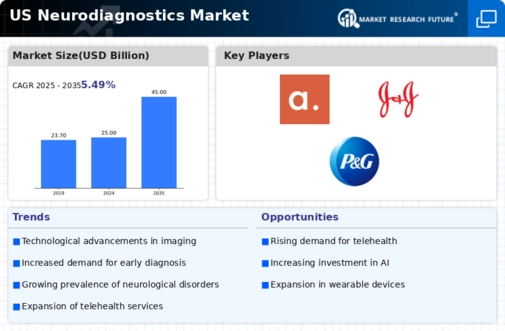Expansion of Telehealth Services
The expansion of telehealth services in the US is influencing the neurodiagnostics market by increasing access to diagnostic services. Telehealth platforms enable healthcare providers to offer remote consultations and assessments, which can be particularly beneficial for patients with neurological conditions who may have mobility challenges. This trend is likely to drive demand for neurodiagnostic tools that can be integrated into telehealth systems, allowing for remote monitoring and diagnosis. As telehealth continues to gain traction, the neurodiagnostics market may see a rise in the development of technologies that facilitate remote neurodiagnostic assessments, thereby enhancing patient care and accessibility.
Growing Demand for Point-of-Care Testing
The shift towards point-of-care testing in the US healthcare system is emerging as a significant driver for the neurodiagnostics market. Patients and healthcare providers increasingly prefer rapid and accurate diagnostic solutions that can be administered at the point of care. This trend is particularly relevant for neurological assessments, where timely diagnosis can lead to better patient management. The market for point-of-care neurodiagnostic devices is projected to grow, with estimates indicating a CAGR of over 10% in the coming years. This growth is likely to be fueled by technological advancements that enable portable and user-friendly diagnostic tools, thereby enhancing accessibility and efficiency in neurological care.
Rising Incidence of Neurological Disorders
The increasing prevalence of neurological disorders in the US is a primary driver for the neurodiagnostics market. Conditions such as Alzheimer's disease, Parkinson's disease, and multiple sclerosis are becoming more common, with estimates suggesting that by 2030, the number of individuals diagnosed with Alzheimer's alone could reach 7.2 million. This surge in cases necessitates advanced diagnostic tools and technologies, thereby propelling the demand for neurodiagnostic solutions. As healthcare providers seek to improve patient outcomes through early detection and accurate diagnosis, the neurodiagnostics market is likely to experience substantial growth. Furthermore, the aging population, which is more susceptible to these disorders, further amplifies the need for effective neurodiagnostic methods.
Increased Investment in Healthcare Infrastructure
The US government and private sector are significantly investing in healthcare infrastructure, which is positively impacting the neurodiagnostics market. Funding initiatives aimed at enhancing diagnostic capabilities and expanding access to advanced neurodiagnostic technologies are becoming more prevalent. For instance, the National Institutes of Health (NIH) has allocated substantial resources to research and development in neurodiagnostics, which is expected to foster innovation and improve diagnostic accuracy. This investment trend is likely to lead to the introduction of new technologies and methodologies, thereby enhancing the overall landscape of the neurodiagnostics market. As healthcare facilities upgrade their equipment and capabilities, the demand for neurodiagnostic tools is anticipated to rise correspondingly.
Regulatory Support for Innovative Diagnostic Solutions
Regulatory bodies in the US are increasingly supporting the development and approval of innovative neurodiagnostic solutions, which is a crucial driver for the neurodiagnostics market. Initiatives aimed at expediting the approval process for new diagnostic technologies are being implemented, allowing for faster access to cutting-edge tools. The FDA's Breakthrough Devices Program, for instance, facilitates the development of devices that provide more effective treatment or diagnosis of life-threatening conditions. This regulatory support is likely to encourage companies to invest in research and development, leading to the introduction of novel neurodiagnostic products that can address unmet clinical needs and improve patient outcomes.














Leave a Comment